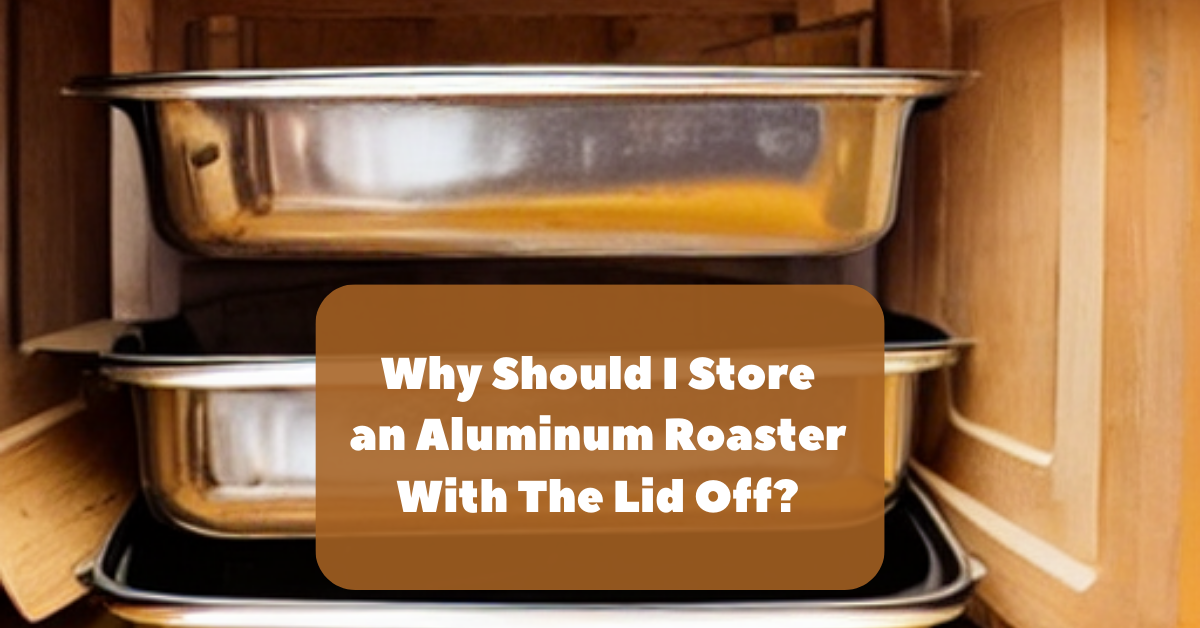If you’re a home chef, you know the importance of having a good roaster in your kitchen.
Aluminum roasters are a popular choice because they are affordable, lightweight, and conduct heat well, making them ideal for roasting a variety of foods.
However, it’s important to store your aluminum roaster properly to ensure that it lasts for years to come.
In this article, we’ll explore the benefits of storing an aluminum roaster with the lid off and why it’s a better choice for preserving the quality of your roaster.
Whether you’re new to cooking with aluminum roasters or you’ve been using them for years, this article will provide you with valuable information on how to properly care for your roaster.
So, let’s get started!
Recommended: 7 Best Benefits of Using an Aluminum Roaster.
Why Should I Store an Aluminum Roaster With The Lid Off?
There are a few reasons why you might want to store an aluminum roaster with the lid off:
- To prevent moisture build-up: When the lid is on, moisture can get trapped inside the roaster, which can lead to rust or other damage over time. Storing the roaster with the lid off allows the inside to air out and prevents moisture from accumulating.
- To allow air circulation: Similar to the first point, storing the roaster with the lid off allows air to circulate around the inside of the roaster. This can help prevent any odors or bacteria from accumulating inside the roaster.
- To prevent dents: If you store the roaster with the lid on, the weight of the lid can cause dents or other damage to the roaster over time. Storing the roaster with the lid off can help prevent this.
- To save space: If you have limited storage space in your kitchen, storing the roaster with the lid off can help save space and allow you to stack other items on top of the roaster.
Overall, storing an aluminum roaster with the lid off can help prevent moisture build-up, allow air circulation, prevent dents, and save space in your kitchen.
However, it’s important to keep the roaster clean and dry to prevent any damage or wear and tear.
The Importance of Preventing Rust in an Aluminum Roaster
Rust is the result of the oxidation of iron or steel, which occurs when these metals come into contact with water and oxygen.
Aluminum is a metal that does not rust, but it can still be affected by rust if it is in contact with iron or steel.
For example, if you have an aluminum roaster with a steel rack, the rack can rust over time if it is not properly cared for.
The importance of preventing rust in an aluminum roaster cannot be overstated.
Rust can weaken the structure of the roaster and make it less durable, which can lead to problems when you are cooking.
Rust can also affect the appearance of the roaster and make it look unsightly.
To prevent rust in an aluminum roaster, it’s important to store the roaster with the lid off to allow the inside to air out and prevent moisture from accumulating.
It’s also important to clean the roaster regularly and dry it thoroughly before storing it.
If the roaster has a steel rack, it’s important to dry the rack thoroughly after each use to prevent rust from forming.
Finally, it’s a good idea to store the roaster in a dry, cool place to help prevent rust from forming.
How Trapped Moisture Can Affect the Non-Stick Coating of Your Aluminum Roaster
Most aluminum roasters have a non-stick coating to make it easier to cook and clean up after meals.
However, trapped moisture can affect the effectiveness of the non-stick coating over time.
When moisture is trapped inside the roaster, it can cause the non-stick coating to become damaged or peel off.
This can make it more difficult to cook with the roaster and can also affect the taste and quality of your food.
In addition, a damaged non-stick coating can be difficult to clean and may require more elbow grease to remove food residue.
To keep your aluminum roaster’s non-stick coating in top condition, it’s essential to prevent moisture from being trapped inside.
One way to do this is by storing the roaster with the lid off, allowing the inside to dry and preventing moisture from accumulating.
Additionally, regularly cleaning and drying the roaster after use will help prevent moisture build-up and maintain the effectiveness of the non-stick coating.
By following these simple steps, you can help ensure that your aluminum roaster’s non-stick coating stays in good condition, providing you with excellent cooking performance for years to come.
Recommended: How Do I Use an Aluminum Roaster With a Lid?
The Role of Air Circulation in Maintaining the Quality of Your Aluminum Roaster
Air circulation plays an important role in maintaining the quality of your aluminum roaster.
When air is able to circulate around the inside of the roaster, it can help prevent moisture from accumulating and causing rust or other damage.
In addition, air circulation can help prevent odors and bacteria from accumulating inside the roaster, which can affect the taste and quality of your food.
To promote air circulation in your aluminum roaster, it’s important to store the roaster with the lid off.
This allows air to circulate around the inside of the roaster and helps prevent moisture from accumulating.
It’s also a good idea to clean and dry the roaster thoroughly after each use to prevent any odors or bacteria from accumulating.
Popular: What Is The Best Way To Store an Aluminum Roaster?
The Dangers of Stacking Heavy Items on Top of an Aluminum Roaster
Stacking heavy items on top of an aluminum roaster can be dangerous for a few reasons.
First, it can cause dents or other damage to the roaster.
Aluminum is a lightweight metal, and it is not designed to bear heavy weights.
When heavy items are placed on top of an aluminum roaster, it can cause the metal to bend or dent, which can affect the roaster’s ability to cook evenly and may also make it more prone to rust.
In addition to causing physical damage, stacking heavy items on top of an aluminum roaster can also be dangerous from a safety standpoint.
If the roaster is not sturdy enough to support the weight of the items stacked on top of it, it can tip over or collapse, potentially causing injury or damage to your kitchen.
To prevent the dangers of stacking heavy items on top of an aluminum roaster, it’s important to store the roaster in a safe and secure location where it is not at risk of being crushed or damaged by other items.
It’s also a good idea to check the roaster regularly for any dents or other damage that may have occurred and to replace the roaster if it is no longer safe to use.
Alternative Storage Options for Aluminum Roasters
There are a few alternative storage options for aluminum roasters that you might want to consider:
- Roaster racks: Some roasters come with racks that can be used to store the roaster off the ground. This can help prevent dents and other damage that can be caused by stacking heavy items on top of the roaster.
- Kitchen cabinets: If you have enough space in your kitchen cabinets, you can store your aluminum roaster in one of them. This can help keep the roaster out of the way and protect it from accidental damage.
- Pantry or closet: If you have a pantry or a closet with enough space, you can store your aluminum roaster in one of these areas. This can help keep the roaster out of the way and prevent it from being damaged by other items in your kitchen.
- Under the bed: If you have a bed with enough clearance, you can store your aluminum roaster under it. This can be a good option if you have limited space in your kitchen and need to keep your roaster out of the way.
Overall, there are many alternative storage options for aluminum roasters, and the best option for you will depend on your specific needs and the layout of your kitchen.
Cleaning and Maintenance Tips for Keeping Your Aluminum Roaster in Great Condition
Proper cleaning and maintenance are essential for keeping your aluminum roaster in great condition.
Here are a few tips to help you keep your roaster in top shape:
- Wash the roaster after each use: To prevent food residue from drying on the roaster and making it harder to clean, be sure to wash the roaster after each use. Use warm, soapy water and a soft sponge or brush to scrub the roaster, and be sure to rinse and dry it thoroughly.
- Avoid using abrasive materials: To avoid scratching or damaging the non-stick coating on your aluminum roaster, be sure to use soft sponges or brushes when cleaning it. Avoid using abrasive materials such as steel wool or scouring pads, as these can damage the coating.
- Store the roaster with the lid off: To prevent moisture from accumulating inside the roaster and causing rust or other damage, be sure to store the roaster with the lid off. This allows the inside to air out and helps prevent moisture from accumulating.
- Dry the roaster thoroughly after each use: To prevent rust or other damage, be sure to dry the roaster thoroughly after each use. This is especially important if the roaster has a steel rack, as the rack is more prone to rusting than the aluminum roaster itself.
By following these simple cleaning and maintenance tips, you can help ensure that your aluminum roaster stays in great condition and provides you with excellent cooking performance for years to come.
Also read: How Do You Clean an Aluminum Roaster?
VIDEO: How to Organize pots, Lids & Pans
Conclusion
In conclusion, storing an aluminum roaster with the lid off is an important part of maintaining the quality and longevity of your roaster.
By allowing the inside to air out and preventing moisture from accumulating, you can help prevent rust and other damage that can affect the roaster’s performance.
In addition, storing the roaster with the lid off can help prevent odors and bacteria from accumulating inside the roaster, which can affect the taste and quality of your food.
Finally, storing the roaster with the lid off can help prevent dents and other physical damage, and can also help save space in your kitchen.

